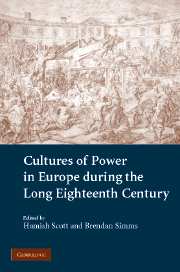Book contents
- Frontmatter
- Contents
- Preface
- List of contributors
- 1 Introduction: culture and power during the long eighteenth century
- 2 When culture meets power: the Prussian coronation of 1701
- 3 Military culture in the Reich, c. 1680–1806
- 4 Diplomatic culture in old regime Europe
- 5 Early eighteenth-century Britain as a confessional state
- 6 ‘Ministers of Europe’: British strategic culture, 1714–1760
- 7 Confessional power and the power of confession: concealing and revealing the faith in Alpine Salzburg, 1730–1734
- 8 The transformation of the Aufklärung: from the idea of power to the power of ideas
- 9 Culture and Bürgerlichkeit in eighteenth-century Germany
- 10 The politics of language and the languages of politics: Latin and the vernaculars in eighteenth-century Hungary
- 11 ‘Silence, respect obedience’: political culture in Louis XV's France
- 12 Joseph II, petitions and the public sphere
- 13 The court nobility and the origins of the French Revolution
- 14 The French Revolution and the abolition of nobility
- 15 Foreign policy and political culture in later eighteenth-century France
- 16 Power and patronage in Mozart's La clemenza di Tito and Die Zauberflöte
- 17 Between Louis and Ludwig: from the culture of French power to the power of German culture, c. 1789–1848
- Index
7 - Confessional power and the power of confession: concealing and revealing the faith in Alpine Salzburg, 1730–1734
Published online by Cambridge University Press: 17 July 2009
- Frontmatter
- Contents
- Preface
- List of contributors
- 1 Introduction: culture and power during the long eighteenth century
- 2 When culture meets power: the Prussian coronation of 1701
- 3 Military culture in the Reich, c. 1680–1806
- 4 Diplomatic culture in old regime Europe
- 5 Early eighteenth-century Britain as a confessional state
- 6 ‘Ministers of Europe’: British strategic culture, 1714–1760
- 7 Confessional power and the power of confession: concealing and revealing the faith in Alpine Salzburg, 1730–1734
- 8 The transformation of the Aufklärung: from the idea of power to the power of ideas
- 9 Culture and Bürgerlichkeit in eighteenth-century Germany
- 10 The politics of language and the languages of politics: Latin and the vernaculars in eighteenth-century Hungary
- 11 ‘Silence, respect obedience’: political culture in Louis XV's France
- 12 Joseph II, petitions and the public sphere
- 13 The court nobility and the origins of the French Revolution
- 14 The French Revolution and the abolition of nobility
- 15 Foreign policy and political culture in later eighteenth-century France
- 16 Power and patronage in Mozart's La clemenza di Tito and Die Zauberflöte
- 17 Between Louis and Ludwig: from the culture of French power to the power of German culture, c. 1789–1848
- Index
Summary
In the eighteenth century, the archbishopric of Salzburg – like the Electorate of Mainz, the subject of Tim Blanning's first monograph – was a semi-independent territory of the Holy Roman Empire ruled by an ecclesiastical prince who wielded both secular and ecclesiastical authority. Like Mainz and other ecclesiastical principalities of the empire, Salzburg retained its semi-autonomous status up to the Napoleonic era, when it was finally absorbed by Habsburg Austria. Today it is of course Mozart, Salzburg's native prodigy, who dominates its carefully burnished baroque facade. But around the time of Mozart's birth in 1756, Salzburg's reputation – at least in Protestant Europe – was coloured by a very different image. It grew out of the notorious Emigrationspatent (1731) of Archbishop Leopold Anton Freiherr von Firmian, an edict that resulted in the expulsion of more than 20,000 Protestants (most of them Lutheran peasants and farmhands) in the years between 1731 and 1734. The majority sought refuge in Protestant Prussia; the remainder settled in other territories of the empire, with a few hundred migrating to James Edward Oglethorpe's newly founded colony of Georgia. The expulsions occasioned a torrent of protest throughout Protestant Europe, while in the empire itself, as Mack Walker has shown, the extraordinary quantity of pamphlets and published sermons sparked by the expulsions made it one of the most resounding causes célèbres of the century.
- Type
- Chapter
- Information
- Cultures of Power in Europe during the Long Eighteenth Century , pp. 133 - 157Publisher: Cambridge University PressPrint publication year: 2007



